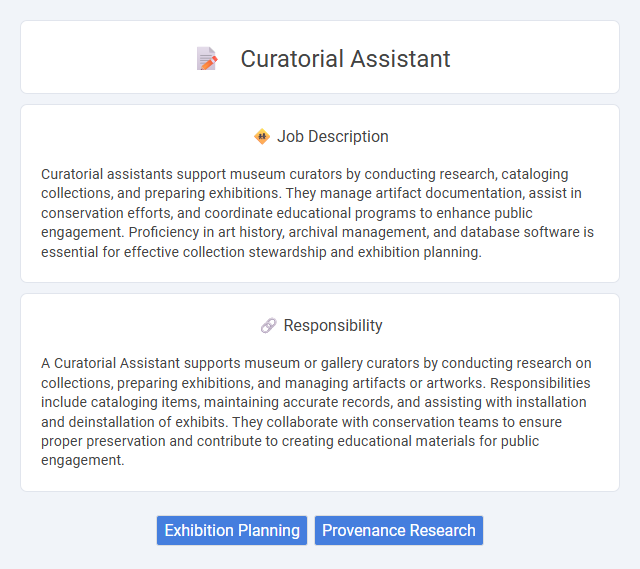
Curatorial assistants support museum curators by conducting research, cataloging collections, and preparing exhibitions. They manage artifact documentation, assist in conservation efforts, and coordinate educational programs to enhance public engagement. Proficiency in art history, archival management, and database software is essential for effective collection stewardship and exhibition planning.
Individuals with strong organizational skills and a passion for art or history are likely to be well-suited for a curatorial assistant job, as the role often requires managing collections and supporting exhibitions. Those who thrive in detail-oriented environments and possess effective communication abilities may find this position rewarding and compatible with their strengths. Candidates who prefer dynamic work settings and have a dedication to preserving cultural artifacts might have a higher probability of success in this field.
Qualification
Curatorial assistant positions require a strong background in art history, museum studies, or a related field, often with a bachelor's or master's degree. Candidates must demonstrate excellent organizational skills, research proficiency, and familiarity with collection management software. Experience in coordinating exhibitions, cataloging artifacts, and assisting with public programming is highly valued by employers.
Responsibility
A Curatorial Assistant supports museum or gallery curators by conducting research on collections, preparing exhibitions, and managing artifacts or artworks. Responsibilities include cataloging items, maintaining accurate records, and assisting with installation and deinstallation of exhibits. They collaborate with conservation teams to ensure proper preservation and contribute to creating educational materials for public engagement.
Benefit
Working as a curatorial assistant likely offers valuable experience in museum or gallery environments, enhancing research and organizational skills crucial for cultural heritage management. The role probably provides opportunities to collaborate with seasoned curators, increasing professional network and industry insight. Gaining hands-on exposure to exhibitions and collections may improve career prospects in art history, museum studies, or related fields.
Challenge
A curatorial assistant job likely involves the challenge of balancing administrative duties with creative input, requiring precision and adaptability in managing exhibitions. This role may demand frequent problem-solving to address unexpected issues with art pieces or event coordination. Navigating the complexity of historical accuracy and contemporary relevance might present ongoing difficulties in supporting curators effectively.
Career Advancement
A Curatorial Assistant supports museum or gallery curators by managing collections, assisting with exhibitions, and conducting research, which builds essential expertise in art handling and archival methods. Mastery in these responsibilities often leads to opportunities for promotion to Curator roles, where professionals oversee entire collections and develop exhibit programming. Advanced skills in collection management software and deep art historical knowledge significantly enhance career progression within cultural institutions.
Key Terms
Exhibition Planning
Curatorial assistants play a critical role in exhibition planning by conducting research on artworks, artists, and historical contexts to support curators in creating cohesive and engaging displays. They coordinate logistics such as scheduling, transportation, and installation, ensuring that all elements align with the exhibition's vision and timeline. Their expertise in collections management and audience engagement helps enhance the overall visitor experience and promote institutional goals.
Provenance Research
Curatorial assistants specializing in provenance research play a critical role in verifying the history and authenticity of artworks and artifacts by examining ownership records, historical documentation, and legal titles. This position requires detailed knowledge of archival research methods, provenance databases, and ethical guidelines for cultural heritage to prevent illicit trade and repatriate stolen cultural property. Expertise in international art laws and collaboration with museums, galleries, and legal authorities ensures comprehensive provenance investigations supporting curatorial decisions.
 kuljobs.com
kuljobs.com